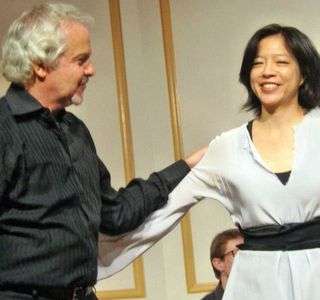|
Back
Rare Jewels from the Stravinsky catalogue New York
W.M.P. Concert Hall, 31 East 28th Street
09/12/2012 - & September 13, 2012
Gil Morgenstern Reflection Series
Igor Stravinsky: Suite Italienne – Violin Concerto: Toccata & Aria I – Firebird: Berceuse & Scherzo – Duo Concertante – Divertimento: Pas de Deux, Variation & Coda
Gil Morgenstern (Violin), J.Y. Song (Piano) 
G. Morgenstern, J. W. Song (© Coco T. Dawg)
Like his composer of the evening, Igor Stravinsky–who rarely called things “sonatas” or “quartet”, and prereferred “Symphonies” to a mere symphony, Gil Morgenstern rarely uses the plebeian “recital.” His programs are part of a “Reflection Series” or “Chamber Theater.” But whatever the name, this violinist has the chops, the fingers, and above all, the intelligence to make all his...er, concerts strand out from the rest.
In the W.M.P., Mr. Morgenstern and J.Y. Song had the ideal setting for these “Reflections.” An elite audience of violinists and string-lovers, an elegant, 18th Century-style stage which was intimate enough for his commentary, yet with sound that resonated over the almost full house.
And in offering a night of “all Stravinsky”, Messrs Morgenstern and Song produced a most unlikely program. Outside of his Concerto, one doesn’t think of that instrument in tandem with the composer. In fact, during one of several informal talks before each piece, Mr. Morgenstern described how wary Stravinsky was of the violin, as he was unable to play the instrument.
That, in fact, was the secret of his success in the Concerto, when he was told that not being able to play the violin, he could develop things–like the chord which introduces each movement–which would make the player stretch out to unknown regions.
The two artists played two of the four movements, and even without orchestra, they showed that this was all lean meat, no gristle, no fillers. Mr. Morgenstern especially gave it a verve, a push, and, with his super fingering, making even that “impossible” chord a thing of easy elegance.
The concert was more than Stravinsky. His homages to Tchaikovsky, supposedly Greek music (like Renaissance composers he could give austere images in the Duo Concertante, without any real knowledge)., and above all, in Pergolesi, and his homage to the 18th Century. \
This was, of course, the Italian Suite, taken from the ballet Pulcinella, taken from Pergolesi tunes, and in turn taken from the orchestral version to soloists. What Mr Morgenstern displayed, more than his brio, his vivacity and a 20th Century sweep of the Baroque music, was how Stravinsky managed to work in all the mordants, trills and grace notes which one needed here.
I was frankly astonished how, in a work I had heard before as tuneful, danceable and clever, was given such a transparent reading. And how, in the confines of the W.M.P. Concert Hall, one could see how the breadth of his fingers dealt out the ornamentation which the composer kept in his arrangement.
Admittedly, the arrangements from Firebird, played with beautiful sounds, did miss the glory of the orchestration. In the Italian Suite, one was happy with the brevity of sounds. Here, one wanted the glory which only an orchestra can give.
But the final Divertimento, where Stravinsky played around with the essence of Tchaikovsky’s salon pieces–pretty but pretty insignificant–Mr. Morgenstern and Ms. Song played with energy, intensity and honesty. It was as if Stravinsky had unmasked the sentimentality and shown the strength behind these tunes in each balletic movement.
Where one could spot the Baroque in each measure of the Suite Italienne, here we had the Russian composer’s own personality. These was “easy” Stravinsky for us listeners, but for Morgenstern and Song, they had the challenge of making of giving color, depth and energy in this delightful partnership.
CODA: From this very live violinist to a suicidal violinist in one day. The anti-hero of the Persian-French movie (which I saw the morning of the concert), Chicken with Plums, decides never to play the violin again (even after buying “the Stradivarius used by Mozart himself” from a rural Iranian antiques dealer). It takes him eight days to accomplish dying, and in that time, Chicken With Plums presents a series of indescribable fantasies, dealing with violins, cigarettes, opium, 1950’s American television and a haunting dialogue with Azreal, the Islamic Angel of Death. The film is more than fantasy: it is Persian fantasy. In other words, it begins with their “once upon a time’ phrase (In Parsi, “It was something…it was nothing”) and continues with eccentric, funny, sad, maudlin, goofy, magical and mesmerizing red herrings. But it is never ever boring. Our hero is supposedly a world-famous violinist (like Gil Morgenstern), but his life and death are made of smoke, stars, illusions and unrealistically gorgeous settings.
Harry Rolnick
|